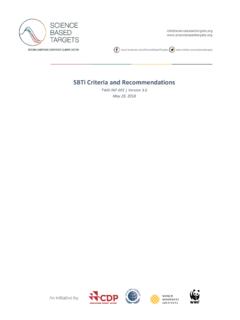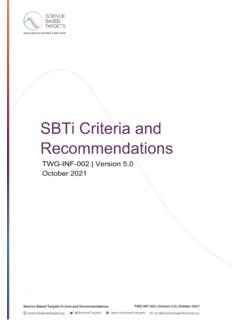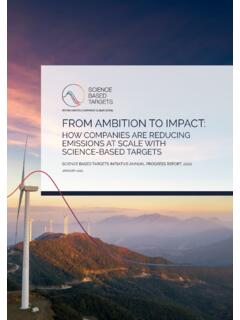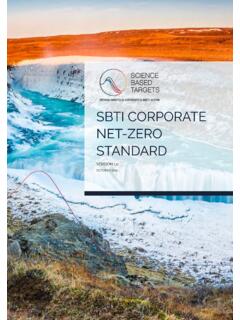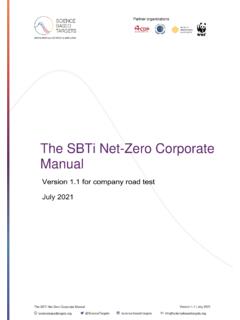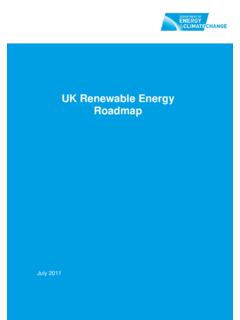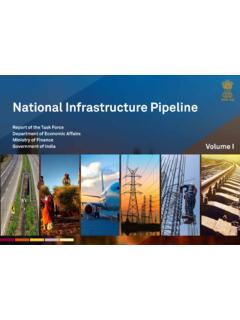Transcription of SCIENCE-BASED TARGET SETTING FOR THE AVIATION SECTOR
1 SCIENCE-BASED TARGET SETTING for the AVIATION SECTOR @ScienceTargets / SCIENCE-BASED -targets Version | August 2021 SCIENCE-BASED TARGET SETTING FOR THE AVIATION SECTORP artner organizations Acknowledgments This guidance was developed by WWF on behalf of the Science Based Targets initiative (SBTi), with support from the International Council for Clean Transportation (ICCT) and Boston Consulting Group (BCG). The Science Based Targets initiative mobilizes companies to set SCIENCE-BASED targets and boost their competitive advantage in the transition to the low-carbon economy. It is a collaboration between CDP, the United Nations Global Compact, World Resources Institute (WRI) and the World Wide Fund for Nature (WWF) and is one of the We Mean Business Coalition commitments. About WWF WWF is one of the world s largest and most experienced independent conservation organizations, with over 5 million supporters and a global network active in more than 100 countries.
2 WWF s mission is to stop the degradation of the planet s natural environment and to build a future in which humans live in harmony with nature, by conserving the world s biological diversity, ensuring that the use of renewable natural resources is sustainable, and promoting the reduction of pollution and wasteful consumption. About BCG Boston Consulting Group partners with leaders in business and society to tackle their most important challenges and capture their greatest opportunities. BCG was the pioneer in business strategy when it was founded in 1963. Today, we help clients with total transformation inspiring complex change, enabling organizations to grow, building competitive advantage, and driving bottom-line impact. To succeed, organizations must blend digital and human capabilities. Our diverse, global teams bring deep industry and functional expertise and a range of perspectives to spark change.
3 BCG delivers solutions through leading-edge management consulting along with technology and design, corporate and digital ventures and business purpose. We work in a uniquely collaborative model across the firm and throughout all levels of the client organization, generating results that allow our clients to thrive. About the ICCT The International Council on Clean Transportation is an independent non-profit organization founded to provide first-rate, unbiased research and technical and scientific analysis to environmental regulators. Its mission is to improve the environmental performance and energy efficiency of road, marine, and air transportation, in order to benefit public health and mitigate climate change. Partner organizations Primary Authors Dan Rutherford (ICCT) Sola Xinyi Zheng (ICCT) Jesper Nielsen (BCG) Paulina Ponce de Le n Barid (BCG) Nicholas Collins (BCG) Fernando Rangel Villasana (WWF) Brad Schallert (WWF) Rebekah Hughes-Khan (WWF) John Holler (WWF) Tim Letts (WWF) A Technical Working Group (TWG) of dedicated experts from industry and NGOs provided detailed input during the planning phase and on various drafts of the guidance and tool.
4 TWG member organizations: Air New Zealand, All Nippon Airways, American Airlines, Cathay Pacific Airways, Deutsche Post DHL Group (DPDHL), EasyJet, Ethiopian Airlines, Federal Express (FedEx), Finnair, GOL, International Airlines Group (IAG), International Energy Agency (IEA), JetBlue Airways, Qantas Airways, The Smart Freight Centre, United Parcel Service (UPS), University College London (UCL) We are very grateful for the input and engagement from all our Technical Working Group members and project support teams. Opinions expressed within this document may not represent the views of every Technical Work Group organization. Partner organizations EXECUTIVE SUMMARY Introduction to Science Based Targets initiative (SBTi) The Science Based Targets initiative (SBTi) helps companies understand how much and how fast they have to reduce greenhouse gas (GHG) emissions by to align with the goals of the Paris agreement - to limit warming to well-below 2 C above pre-industrial levels and pursue efforts to limit warming to C.
5 This document provides guidance on how airlines and users of AVIATION services should set targets aligned with a well-below 2 C ambition (the goal of the Paris agreement). TARGET SETTING approach for airlines The TARGET SETTING method for airlines is based on the SBTi s Sectoral Decarbonization Approach (SDA) which states that a company s carbon intensity should converge to the SECTOR s Paris-aligned GHG intensity by 2050 Decarbonization pathway for the AVIATION SECTOR The rate and scale of AVIATION decarbonization is defined by the International Energy Agency s (IEA) Energy Technology Perspectives (ETP) 2020 report which models GHG reduction requirements for each SECTOR based on a number of assumptions including forecasted SECTOR growth, availability of mitigation levers and socio- economic factors To align with the Paris agreement, the AVIATION SECTOR is required to reduce average carbon intensity by ~35-40% between 2019-2035, or ~65% from 2019-2050 Scope of emissions covered The impact of AVIATION non-CO factors on warming is acknowledged but not included in quantitative TARGET SETTING due to scientific uncertainty and lack of mitigation solutions To raise awareness of non-CO impacts of AVIATION , airlines are encouraged to participate in data sharing, collaboration and include non-CO factors in other climate commitments Process to set a TARGET Companies may use the accompanying SBT AVIATION Excel tool to help set SBTs Partner organizations Once a TARGET has been developed.
6 It should be submitted to the SBTi for validation Mechanisms to realize targets The SBTi does not prescribe a technology roadmap for meeting targets, however, airlines may consider improving carbon intensity through fleet renewal, improved operational efficiency, adoption of Sustainable AVIATION Fuels or other solutions SCIENCE-BASED reduction targets currently address in-value-chain reductions, hence out-of-value-chain neutralization or compensation1 credits cannot be used to meet SBTs However, SCIENCE-BASED reduction targets can be complemented by SCIENCE-BASED Net Zero targets (under development) which further consider the role of CO removals/credits SBTs for users of AVIATION services This pathway can be used to set targets for scope 3 category 4 upstream transportation and distribution ( , contracted freight), scope 3 category 9 downstream transportation and distribution or for scope 3 category 6 business travel emissions Business air travel targets are generated using the absolute contraction method with a linear annual reduction rate of (the SECTOR decarbonization rate for 2019-2050) SAF can be used to address scope 3 targets if procured in line with SBTi principles 1 Compensation: Measurable climate mitigation outcomes, resulting from actions outside of the value-chain of a company that compensate for emissions that remain unabated within the value-chain of a company.
7 In the contest of the SBTi, the term compensation also refers to a company s actions or investments that mitigate, or are made with the intention to mitigate, GHG emissions beyond those mitigated by its SBT and net-zero TARGET . Neutralization: To reach a state in which human activity no longer contributes to global warming means achieving a state in which anthropogenic GHG emissions no longer accumulate in the atmosphere. For companies, this means neutralizing the impact of any source of residual emissions that is unfeasible to eliminate by permanently removing an equivalent volume of atmospheric CO2. Partner organizations TABLE OF CONTENTS EXECUTIVE SUMMARY .. 3 CONTEXT .. 6 WHAT ARE SCIENCE-BASED TARGETS (SBTS) .. 6 THE AVIATION SECTOR IN CONTEXT .. 6 OVERVIEW OF THE PUBLIC CONSULTATION PROCESS .. 7 DEVELOPMENT OF AVIATION DECARBONIZATION TRAJECTORIES .. 8 OVERVIEW OF THE SECTORAL DECARBONIZATION APPROACH (SDA) .. 8 CHOICE OF EMISSIONS SCENARIO AND ACTIVITY FORECAST.
8 9 SECTOR ACTIVITY FORECAST .. 11 APPROACH TO SECTORAL SEGMENTATION .. 13 PATHWAY BOUNDARIES AND ASSUMPTIONS .. 15 ADDRESSING NON-CO EFFECTS OF AVIATION .. 16 SECTOR CARBON INTENSITY PATHWAYS .. 17 HOW TO SET A SCIENCE-BASED TARGET FOR AVIATION COMPANIES .. 19 USING THE TARGET SETTING TOOL .. 19 SUBMITTING A TARGET FOR VALIDATION .. 21 COMMUNICATING A TARGET .. 21 UPDATING A TARGET .. 21 MECHANISMS TO REALIZE TARGETS .. 23 IMPROVING EFFICIENCY OF TECHNOLOGY AND OPERATIONS .. 23 USING SUSTAINABLE AVIATION 24 APPLICABILITY OF COMPENSATION AND NEUTRALIZATION .. 27 TARGET SETTING FOR USERS OF AVIATION SERVICES .. 28 SCOPE 3 CATEGORIES 4 AND 9 TARGET SETTING METHOD .. 28 SCOPE 3 CATEGORY 6 TARGET SETTING METHOD .. 29 CONCLUDING REMARKS AND FUTURE 32 GLOSSARY .. 33 Partner organizations CONTEXT What are SCIENCE-BASED targets (SBTs) SBTs specify how much and how quickly a company needs to decarbonize to align with the Paris Agreement goals SCIENCE-BASED targets specify how much and how quickly a company would need to reduce its greenhouse gas (GHG) emissions in order to align with the goals of the Paris Agreement - to limit warming to well-below 2 C above pre-industrial levels (WB-2 C) and pursue efforts to further limit warming to C.
9 This report builds on existing Science Based Targets initiative guidance, in particular the SBTi Transport TARGET SETTING Guidance (2018), and the GHG Protocol Corporate Accounting and Reporting Standard to outline how much and how quickly the AVIATION industry needs to decarbonize to meet the goals of the Paris Agreement. It shows the conclusions of a group of experts and industry stakeholders2 that have been focused on developing best practices for SCIENCE-BASED TARGET SETTING in AVIATION since March 2020. This SCIENCE-BASED TARGET SETTING methodology for AVIATION has been built on the SBTi s Sectoral Decarbonization Approach (SDA) which allows AVIATION industry stakeholders including passenger and cargo airlines, contracted freight forwarders and business travelers to set GHG intensity targets that are aligned with a WB-2 C scenario (the temperature goal outlined in the Paris agreement).
10 The AVIATION SECTOR in context AVIATION is considered a heavy-emitting SECTOR , but the SECTOR needs to act now to respond to increasing regulatory, investor and consumer pressures Because of its relatively higher abatement costs than the rest of the economy, AVIATION is considered to be a hard to abate SECTOR , representing ~ of global CO emissions in 2018. Efforts to decarbonize air travel face significant headwinds due to large technical barriers 2 The AVIATION pathway development process has been supported by analysis from the International Council on Clean Transportation, a Technical Working Group involving >15 representatives from airlines, freight carriers, research organizations and industry bodies Partner organizations associated with removing or replacing jet fuel, challenging industry fundamentals, such as low profit margins (2-4% global average) and limited historic regulatory pressure to decarbonize.

